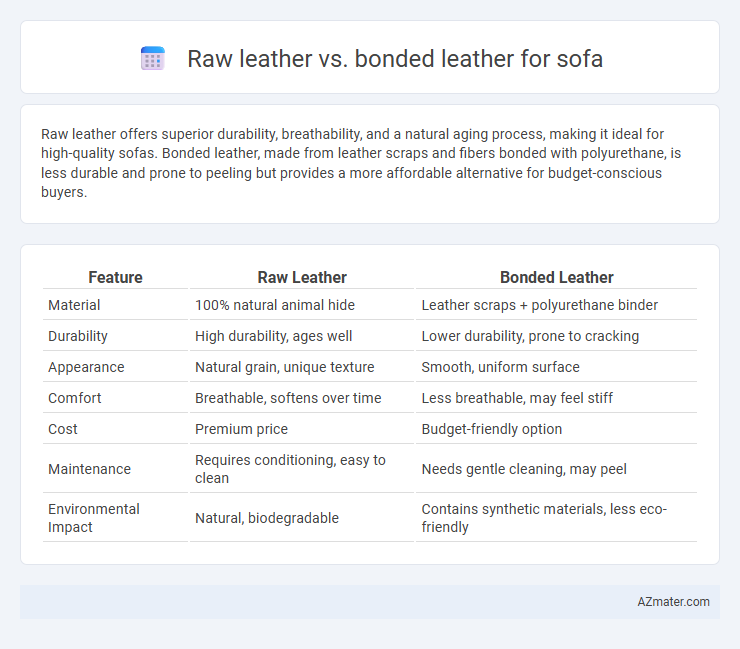Raw leather offers superior durability, breathability, and a natural aging process, making it ideal for high-quality sofas. Bonded leather, made from leather scraps and fibers bonded with polyurethane, is less durable and prone to peeling but provides a more affordable alternative for budget-conscious buyers.
Table of Comparison
| Feature | Raw Leather | Bonded Leather |
|---|---|---|
| Material | 100% natural animal hide | Leather scraps + polyurethane binder |
| Durability | High durability, ages well | Lower durability, prone to cracking |
| Appearance | Natural grain, unique texture | Smooth, uniform surface |
| Comfort | Breathable, softens over time | Less breathable, may feel stiff |
| Cost | Premium price | Budget-friendly option |
| Maintenance | Requires conditioning, easy to clean | Needs gentle cleaning, may peel |
| Environmental Impact | Natural, biodegradable | Contains synthetic materials, less eco-friendly |
Introduction to Raw Leather and Bonded Leather
Raw leather, also known as full-grain leather, is derived from the top layer of animal hide, prized for its durability, natural texture, and aging properties that develop a unique patina over time. Bonded leather is a manufactured material made by combining shredded leather fibers with synthetic binders, offering a more affordable, but less durable and less breathable alternative. Understanding the differences in composition and quality between raw leather and bonded leather is crucial when selecting a sofa upholstered in either material.
What is Raw Leather?
Raw leather, often referred to as full-grain leather, is the highest quality leather made from the top layer of the animal hide, preserving its natural texture and durability. Unlike bonded leather, which is manufactured from leather scraps combined with polyurethane, raw leather undergoes minimal processing, allowing it to age gracefully and develop a unique patina over time. This natural authenticity makes raw leather a premium choice for sofas, offering superior strength, breathability, and long-lasting comfort.
What is Bonded Leather?
Bonded leather is a synthetic material created by combining shredded genuine leather fibers with a polyurethane or latex backing to form a durable, leather-like surface. It offers a more affordable and eco-friendly alternative to raw leather while maintaining a similar appearance and texture. Bonded leather is less durable and prone to peeling compared to raw leather but is popular for budget-friendly sofa upholstery.
Durability: Raw Leather vs Bonded Leather
Raw leather offers superior durability for sofas, characterized by its natural fiber strength and resistance to wear and tear over time. Bonded leather, composed of leather scraps bonded with polyurethane or latex, tends to degrade faster, showing peeling and cracking within a few years. Investing in raw leather sofas ensures longer-lasting quality and longevity compared to the less durable bonded leather alternatives.
Comfort and Feel Comparison
Raw leather offers a natural, breathable texture that softens over time, providing superior comfort and a luxurious feel ideal for premium sofas. Bonded leather, made from leather scraps bonded with polyurethane, tends to be less breathable and less supple, often resulting in a stiffer and less comfortable seating experience. The durability and comfort of raw leather surpass bonded leather, making it a preferred choice for users prioritizing a plush and long-lasting sofa feel.
Appearance and Aesthetics Differences
Raw leather offers a natural, unique grain with rich textures and variations that enhance a sofa's luxurious appearance. Bonded leather, made from leather scraps mixed with polyurethane, lacks the authentic texture and tends to have a uniform, synthetic look that may diminish the sofa's overall aesthetic appeal. The deep patina and aging characteristics of raw leather contribute to a sophisticated, timeless style that bonded leather cannot replicate.
Maintenance and Cleaning Tips
Raw leather sofas require regular conditioning with a pH-balanced leather conditioner to prevent drying and cracking, and should be cleaned with a damp cloth or specialized leather cleaner to remove dirt without damaging the surface. Bonded leather sofas demand gentle cleaning using a soft cloth and mild soap solution to avoid peeling or separation, and benefit from avoiding excessive moisture and direct sunlight to maintain their appearance. Proper maintenance of both materials extends sofa longevity and preserves aesthetic appeal while minimizing costly repairs.
Cost Analysis: Investment vs Budget
Raw leather sofas demand higher upfront investment due to premium quality, durability, and natural texture, making them cost-effective over time with less frequent replacements. Bonded leather sofas offer a budget-friendly alternative by using leather scraps processed with adhesives, but they tend to wear out faster and may require replacement or repair sooner. Evaluating long-term value, raw leather supports greater return on investment despite initial higher cost, whereas bonded leather suits limited budgets prioritizing immediate affordability.
Environmental Impact and Sustainability
Raw leather, derived from unprocessed animal hides, typically has a higher environmental footprint due to resource-intensive tanning processes and animal agriculture impacts. Bonded leather, made by blending leather scraps with polyurethane or other synthetic materials, offers a more sustainable use of leather waste by reducing landfill contributions but may include plastics that hinder biodegradability. Choosing raw leather impacts water consumption and chemical pollution more severely, while bonded leather promotes material recycling yet raises concerns about microplastic pollution and durability.
Final Verdict: Which is Best for Your Sofa?
Raw leather offers superior durability, natural texture, and ages beautifully, making it the best choice for long-lasting, high-quality sofas. Bonded leather, while more affordable and eco-friendly by using scraps, tends to wear quickly and lacks the authentic leather feel. For a sofa investment prioritizing comfort, longevity, and aesthetic appeal, raw leather is the optimal material.

Infographic: Raw leather vs Bonded leather for Sofa
 azmater.com
azmater.com